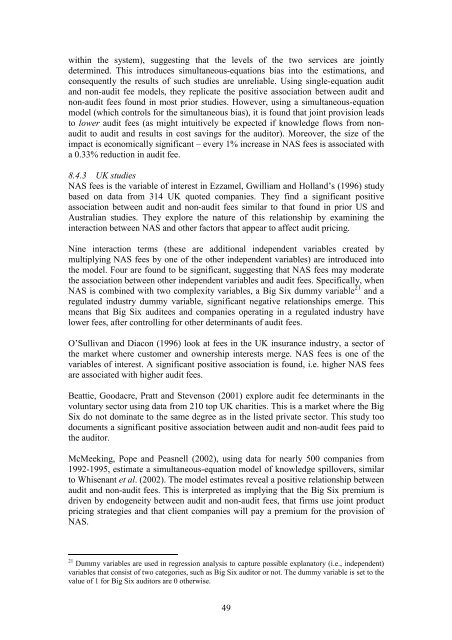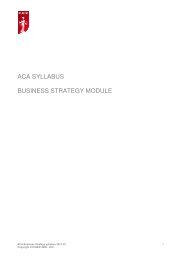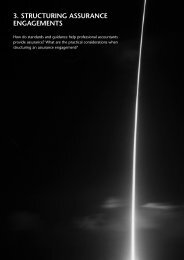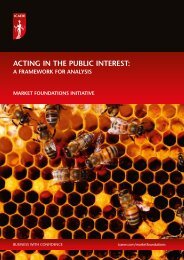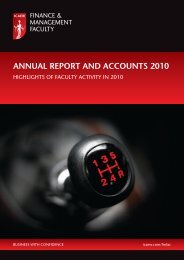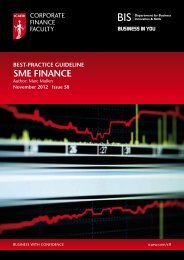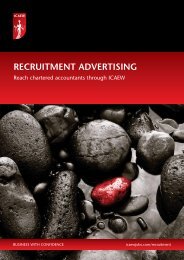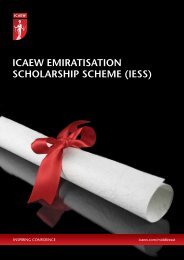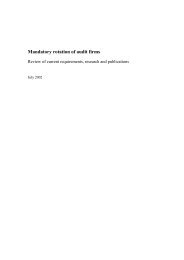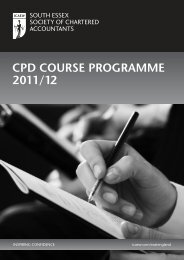Auditor independence and non-audit services - ICAEW
Auditor independence and non-audit services - ICAEW
Auditor independence and non-audit services - ICAEW
Create successful ePaper yourself
Turn your PDF publications into a flip-book with our unique Google optimized e-Paper software.
within the system), suggesting that the levels of the two <strong>services</strong> are jointlydetermined. This introduces simultaneous-equations bias into the estimations, <strong>and</strong>consequently the results of such studies are unreliable. Using single-equation <strong>audit</strong><strong>and</strong> <strong>non</strong>-<strong>audit</strong> fee models, they replicate the positive association between <strong>audit</strong> <strong>and</strong><strong>non</strong>-<strong>audit</strong> fees found in most prior studies. However, using a simultaneous-equationmodel (which controls for the simultaneous bias), it is found that joint provision leadsto lower <strong>audit</strong> fees (as might intuitively be expected if knowledge flows from <strong>non</strong><strong>audit</strong>to <strong>audit</strong> <strong>and</strong> results in cost savings for the <strong>audit</strong>or). Moreover, the size of theimpact is economically significant – every 1% increase in NAS fees is associated witha 0.33% reduction in <strong>audit</strong> fee.8.4.3 UK studiesNAS fees is the variable of interest in Ezzamel, Gwilliam <strong>and</strong> Holl<strong>and</strong>’s (1996) studybased on data from 314 UK quoted companies. They find a significant positiveassociation between <strong>audit</strong> <strong>and</strong> <strong>non</strong>-<strong>audit</strong> fees similar to that found in prior US <strong>and</strong>Australian studies. They explore the nature of this relationship by examining theinteraction between NAS <strong>and</strong> other factors that appear to affect <strong>audit</strong> pricing.Nine interaction terms (these are additional independent variables created bymultiplying NAS fees by one of the other independent variables) are introduced intothe model. Four are found to be significant, suggesting that NAS fees may moderatethe association between other independent variables <strong>and</strong> <strong>audit</strong> fees. Specifically, whenNAS is combined with two complexity variables, a Big Six dummy variable 21 <strong>and</strong> aregulated industry dummy variable, significant negative relationships emerge. Thismeans that Big Six <strong>audit</strong>ees <strong>and</strong> companies operating in a regulated industry havelower fees, after controlling for other determinants of <strong>audit</strong> fees.O’Sullivan <strong>and</strong> Diacon (1996) look at fees in the UK insurance industry, a sector ofthe market where customer <strong>and</strong> ownership interests merge. NAS fees is one of thevariables of interest. A significant positive association is found, i.e. higher NAS feesare associated with higher <strong>audit</strong> fees.Beattie, Goodacre, Pratt <strong>and</strong> Stevenson (2001) explore <strong>audit</strong> fee determinants in thevoluntary sector using data from 210 top UK charities. This is a market where the BigSix do not dominate to the same degree as in the listed private sector. This study toodocuments a significant positive association between <strong>audit</strong> <strong>and</strong> <strong>non</strong>-<strong>audit</strong> fees paid tothe <strong>audit</strong>or.McMeeking, Pope <strong>and</strong> Peasnell (2002), using data for nearly 500 companies from1992-1995, estimate a simultaneous-equation model of knowledge spillovers, similarto Whisenant et al. (2002). The model estimates reveal a positive relationship between<strong>audit</strong> <strong>and</strong> <strong>non</strong>-<strong>audit</strong> fees. This is interpreted as implying that the Big Six premium isdriven by endogeneity between <strong>audit</strong> <strong>and</strong> <strong>non</strong>-<strong>audit</strong> fees, that firms use joint productpricing strategies <strong>and</strong> that client companies will pay a premium for the provision ofNAS.21 Dummy variables are used in regression analysis to capture possible explanatory (i.e., independent)variables that consist of two categories, such as Big Six <strong>audit</strong>or or not. The dummy variable is set to thevalue of 1 for Big Six <strong>audit</strong>ors are 0 otherwise.49


